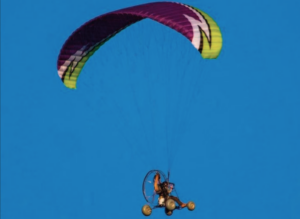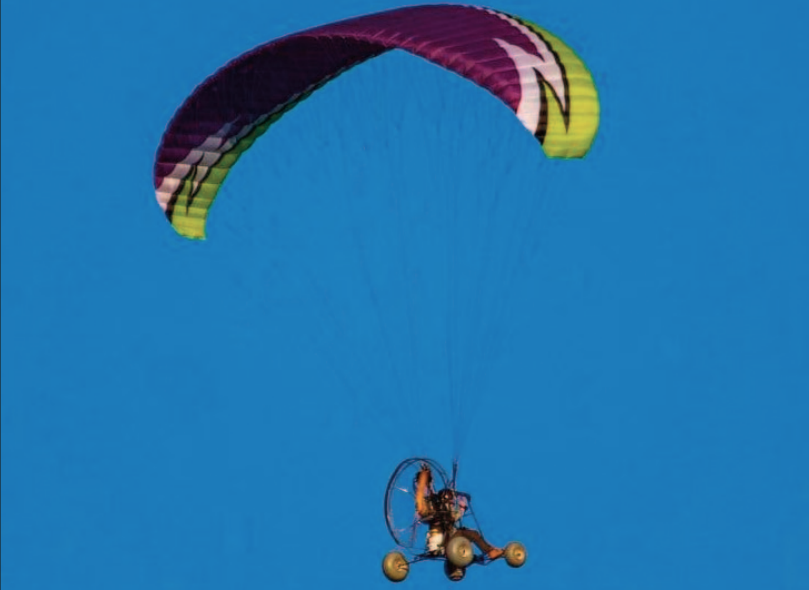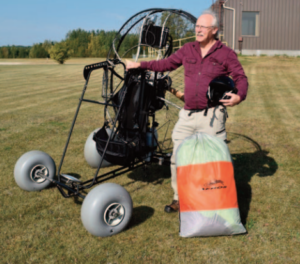
Daryn Watson has the best views in town, or should we say “above town”. Photo by Dave Fitzpatrick – Ghostcod
Swan Hills residents have been seeing some new and interesting sights in the sky over the past few years. You may have found yourself walking around town on a quiet, still day, and then you hear a small engine in the distance. At first, you might think it’s probably a quad or something along that line… maybe a lawn mower? As the sound comes closer, you begin to realize that it is coming from above. Looking up, you behold a sight that doesn’t quite make sense; is that a go-kart hanging from a parachute? Not exactly; you’ve just had your first paramotor sighting.
A paramotor is essentially a paraglider with an engine, allowing for powered flight. The engine is typically a small twostroke model due to the high thrust-to-weight ratio, used to power a propeller, providing the thrust for flight. The engine can be mounted in two basic setups. One way is to mount the engine in a frame with the fuel tank and propeller, worn like a large backpack. The other option is to mount this equipment onto a wheeled launch unit, usually a trike with three wheels or a quad with four wheels. The paramotor wing, a specialized parachute, is then connected to the frame of the paramotor unit. The pilot controls the unit’s thrust with a handheld throttle, while steering is accomplished with a pair of steering lines (also referred to as brake toggles).
The Grizzly Gazette caught up to Town Councillor Daryn Watson, the paramotor pilot most often seen in the skies above Swan Hills, to learn about paramotoring. Daryn had started out with paragliding when he lived in Calgary, which generally requires a hill with very few obstacles (trees, buildings, etc.) to launch. After moving to Swan Hills, he found that there weren’t really any hills in the area suitable for launching a paraglider; he was going to have to try a different approach.
Daryn discussed the matter with a friend from work at the Swan Hills Treatment Centre, and they decided that paramotoring was the way to go. In 2018, Daryn took the necessary pilot training with Sky-Biker Aviation in Wetaskiwin, along with his friend from work and that person’s father. The course consisted of 10 hours of training along with 30 supervised takeoffs and landings. After completing the course, the group was able to write the exam to earn an ultralight pilot’s license specific to paramotors.
Daryn’s paramotor setup is on a lightweight quad frame (with four wheels) with a 250 cc twostroke Polini engine with an electric start. The engine operates with a handheld throttle that also controls the electric start and an engine kill switch. The fuel tank holds 10 L of 100LL aviation fuel, which will keep the engine running for about two and a half hours. Add in the pilot’s seat and safety harness, and the entire unit weighs roughly 100 lbs. Daryn’s wing measures 33 m2, weighs 7 kg and will support up to 600 lbs.
While Daryn has flown as high as 8000 ft, he prefers to fly closer to the ground, saying, “One thousand feet or less is nice for sightseeing; I can see people waving.” Calm weather is ideal for paramotoring, with winds no stronger than 16 km/hr. Safety is of the utmost importance, with a full round of safety checks before even considering getting airborne. As Daryn puts it, “if it’s not right, you don’t go.” Having a flight plan is also essential.
Unfortunately, Daryn couldn’t take his paramotor up on the day that The Gazette caught up to him. One of the safety checks didn’t pass, so Daryn made the responsible choice to postpone his flight until the problem could be fixed.
Hopefully, the fall weather provides plenty of opportunities for Daryn to get up in the air before winter arrives. Keep your eyes on the sky and give Daryn a wave if you see him flying his paramotor.



